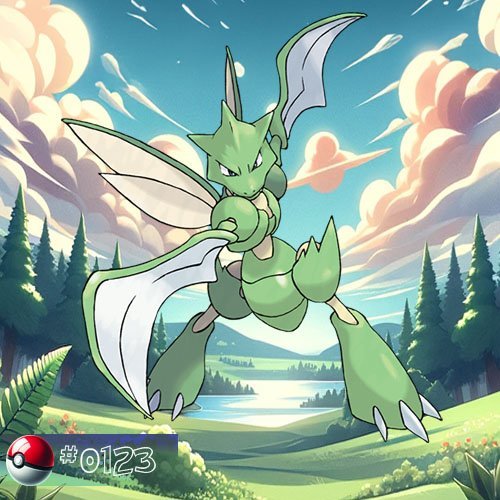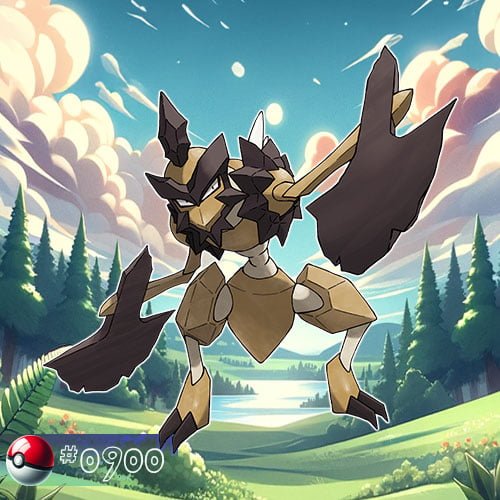Scyther
Scyther is a dual Bug/Flying-type Pokémon known for its speed and scythe-like arms. It’s often depicted as a formidable hunter in the Pokémon world.
Biology
Physical Characteristics
Scyther is a dual-type Pokémon known for its striking appearance and formidable abilities. Here are detailed insights into the physical characteristics of Scyther.
Scyther has a humanoid shape with a distinct insectoid appearance. It stands at an average height of 1.5 meters (4 feet 11 inches) and weighs around 56 kilograms (123.5 pounds). The body is primarily green with a segmented, armor-like exoskeleton covering its torso. It has large, scythe-like blades as arms, which are its most iconic feature. These blades are sharp and can be used for powerful slashing attacks.
Scyther has a triangular head with large, round eyes that are typically red or orange in color. The mouth are small, and it has two pointed, beak-like structures that resemble mandibles. Scyther’s wings are large and thin, featuring a vibrant green coloration with blade-like edges. These wings enable Scyther to achieve impressive flight capabilities, making it agile and swift in battle.
Scyther has six legs, each ending in a three-toed foot with sharp claws. The legs are designed for both ground movement and agile aerial maneuvers, contributing to Scyther’s exceptional speed and agility. The abdomen is elongated and segmented, with a pointed tip. It houses vital organs and contributes to Scyther’s overall streamlined appearance.
Scyther possesses acute senses, including keen eyesight that allows it to track fast-moving targets. Its antennae are likely used for detecting environmental cues and signals, aiding in navigation and communication.
In summary, Scyther is a visually striking Pokémon with a combination of insectoid and humanoid features. Its scythe-like arms, large wings, and agile body make it a formidable predator in the Pokémon world.
Behaviour
The behavior of Scyther is characterized by its predatory nature, agility, and territorial instincts. Here are detailed insights into the behavior of this Pokémon.
Scyther is a natural predator with sharp scythe-like arms that it uses to capture and slice through its prey. Its hunting style involves swift and precise slashing movements. Scyther is known to be territorial, and it often claims a certain area as its hunting grounds. It fiercely defends its territory from other Pokémon, especially potential threats or rivals.
With its six legs and large wings, Scyther is incredibly agile both on the ground and in the air. It uses its agility to navigate through dense vegetation and quickly respond to any potential threats or prey. Scyther’s wings enable it to achieve impressive flight capabilities. It can soar through the air with great speed and maneuverability, making it difficult for opponents to catch or evade.
While Scyther is known to be territorial, it is also capable of forming social groups. Within these groups, Scyther may communicate using various sounds, body language, or possibly pheromones to establish hierarchy and coordinate hunting strategies.
Scyther’s hunting strategies involve using its keen eyesight to spot potential prey from a distance. Once a target is identified, it employs its speed and agility to close in rapidly, delivering swift slashing attacks with its scythe-like arms. Scyther exhibits protective instincts, especially towards its offspring. It is likely to fiercely defend its nest or young Scyther against any perceived threats, showcasing a nurturing side to its usually aggressive demeanor.
Scyther is primarily active during the day, but some reports suggest that it may also engage in nocturnal hunting. Its ability to fly and navigate in low-light conditions contributes to its versatility as a hunter.
Scyther, when trained by Pokémon trainers, can form strong bonds and exhibit loyalty. While its predatory instincts remain, a well-trained Scyther can become a valuable ally in battles and competitions.
In summary, Scyther’s behavior revolves around its predatory instincts, territorial nature, and remarkable agility. Its ability to fly, coupled with sharp scythe-like arms, makes it a formidable hunter in the Pokémon world. Despite its aggressive tendencies, Scyther can form social bonds and display protective behaviors within its group or with its trainer.
Evolution
Scyther undergoes evolution in the Pokémon world, transforming into a more powerful and specialized form. Here are detailed insights into the evolution of Scyther.
Scyther is the basic form of this evolutionary line. It is a dual-type Bug/Flying Pokémon known for its unique and striking appearance, featuring scythe-like arms, large wings, and a humanoid-insectoid body structure.
Scyther evolves into Scizor when traded while holding a Metal Coat. The Metal Coat is an item that enhances the evolution process, causing certain Pokémon to undergo a transformation when traded while holding it. The Metal Coat is a metallic item that represents a layer of protective armor. When Scyther holds a Metal Coat and is traded, the influence of this item triggers its evolution, resulting in the transformation into Scizor.
Upon evolution, Scyther undergoes a significant physical transformation, evolving into Scizor. Scizor loses its Flying type, becoming a dual-type Bug/Steel Pokémon. Scizor retains the humanoid-insectoid appearance but undergoes notable changes. The most noticeable difference is the development of a hard, metallic exoskeleton that enhances its defenses. The scythe-like arms of Scyther are replaced by large, blade-like pincers, which are now part of Scizor’s anatomy. These pincers are used for both offense and defense.
Scizor generally experiences an increase in its base stats upon evolution. The transformation into a Bug/Steel type Pokémon grants Scizor additional resistances and immunities, making it more resilient in battles. Scizor gains access to new moves and tactics that complement its Bug/Steel typing. It becomes a versatile and formidable Pokémon with a balanced combination of offensive and defensive capabilities.
In Hisui region, Scyther evolves into Kleavor when exposed to a Black Augurite. Kleavor is a dual-type Bug/Rock Pokémon introduced in Pokémon Legends: Arceus. Kleavor has a mantis-like appearance with a craggy, rock-like exoskeleton and distinctive features, including large axe-like appendages made of heavy black rock. Evolving through Black Augurites, Kleavor’s body, adorned with stones, reflects battle experience, and its stone shards are used for crafting tools by Hisui settlers.
In summary, the evolution of Scyther into Scizor is triggered by trading while holding a Metal Coat, resulting in a more robust and specialized Pokémon.
Appearances
Anime Main Appearances
Tracey’s Scyther
In the episode “Tracey Gets Bugged”, Tracey, a Pokémon Watcher and a former traveling companion of Ash, captures an aged Scyther following the resolution of its conflict with the once-led horde of Scyther. Despite its advanced years, the elderly Scyther remains highly aggressive, leading Tracey to refrain from utilizing it actively.
Bugsy’s Scyther
During the Gym battle in “Gettin’ The Bugs Out” Bugsy, the Gym Leader of Azalea Town’s Gym, utilizes a Scyther against Ash. This particular Scyther has been trained to deflect Fire-type attacks using Swords Dance as a fan-like defense. Ash discovers a flaw in this strategy when using a Fire-type move from above, allowing his Cyndaquil to secure victory in the Gym match.
Goh’s Scyther
In the episode “Working My Way Back to Mew!”, Goh captures a Scyther. Later, in “Searching for Chivalry!” it evolves into a Scizor through a trade facilitated by a trade machine, holding a Metal Coat received from Wikstrom.
Other appearences include episodes:
- “Showdown at Dark City” (Yas’s Scyther takes on the role of the primary Pokémon at the Yas Gym. This Scyther played a pivotal part in the conflicts between the Kas and Yas Gyms in Dark City.)
- “Mewtwo Strikes Back” and its remake “Mewtwo Strikes Back—Evolution,” (Corey’s Scyther, featured in both was captured and cloned by Mewtwo. During the original movie, Team Rocket mistook the Scyther clone for an Alakazam. The cloned Scyther made a reappearance in “Mewtwo Returns”.)
- “The Fourth Round Rumble,” (During the Indigo Plateau Conference in Jeanette Fisher utilized a Scyther in her battle against Ash. Despite facing a type disadvantage against Bulbasaur, it was defeated. The Scyther reappeared in a flashback in “Bulbasaur… the Ambassador!”.)
- “Navel Maneuvers” (Danny’s Scyther played a crucial role in helping his Machoke and Nidoqueen carve a sled during the second challenge against Ash. It later participated in a sled race alongside Danny’s Electrode and Geodude. Flashbacks featuring Danny’s Scyther were shown in “A Way Off Day Off” and “Hello, Pummelo!”.)
- “Tracey Gets Bugged” (Numerous Scyther inhabited Murcott Island, including one owned by Tracey.)
- “Celebi: The Voice of the Forest” (Pokémon poacher utilized a Scyther and a Houndoom to pursue a Celebi.)
- “Tag, We’re It!” (During the Hearthome City Tag Battle Competition a girl’s Scyther teamed up with Giant’s Koffing. Together, they faced Dawn’s Piplup and Conway’s Slowking.)
- “Explorers of Time & Darkness” (Scyther was a member of Team Razor Wind, alongside a Sandslash and Zangoose. This trio, expelled from the Wigglytuff Guild, attempted to outpace Team Poképals in acquiring a Gabite Scale from Labyrinth Cave. Unfortunately, Gabite easily defeated them. The team reappeared in “Explorers of Sky – Beyond Time & Darkness”.)
- “Pulling Out the Pokémon Base Pepper!” (Scyther served as the umpire for the Pokémon Base game in which Ash and his classmates participated at the Pokémon School.)
Anime Minor Appearances
Throughout various Pokémon episodes and scenarios Scyther appeared:
- Koga’s Scyther lost to Otoshi’s Marowak in a Gym battle in “Bad To The Bone” granting Otoshi the Soul Badge.
- A pink Scyther appeared in Team Rocket’s fantasy in “In the Pink”.
- “Wired for Battle!” showcased a Scyther in Muramasa’s dojo.
- “Tricks of the Trade” featured a Scyther at the Pokémon Swap Meet in Palmpona.
- In “Carrying On!” a sick Scyther was treated at Way Away Island’s Pokémon Center.
- The opening intro of “Celebi: The Voice of the Forest” and “Pokémon Heroes: Latios & Latias” included a Scyther.
- In a flashback in “Throwing in the Noctowl” a Scyther was defeated by Wings Alexander’s Hoothoot.
- “Extreme Pokémon!” highlighted a Scyther in the Extreme Pokémon Race.
- In “Gonna Rule The School!” the Pokémon Trainers’ School lent a Scyther to underage students for lessons.
- A Scyther was part of a demolition crew in “Celebi and Joy!” and had an unknown fate after the crew turned into construction workers.
- In “Reversing the Charges” a Scyther was defeated by an overcharged Elekid and found by Team Rocket.
- Luna’s Scyther, evolving into Scizor, appeared in flashbacks in “Curbing the Crimson Tide”.
- A Coordinator’s Scyther competed in the Jubilife Contest’s Performance Stage in “Mounting a Coordinator Assault!”.
- “I Choose You!” and “The Long Vault Home!” featured Scyther appearances.
- In “Mewtwo Strikes Back—Evolution”, a Scyther was at Old Shore Wharf.
- “Trade, Borrow, and Steal!” showcased a Scyther in Kricketina Kylie’s Bug-type Pokémon collection.
- A Scyther made an appearance in “This Could be the Start of Something Big!”.
- Two Scyther were in “The Treasure After the Storm!” and returned in “Found You, Fuecoco!” to help repair damage to the Brave Olivine.
- A Scyther was seen in “The Ancient Poké Ball”.
Multiple Scyther appeared in the episodes ”The Bug Stops Here” (participated in the Bug-Catching Contest) and ”Mewtwo Returns”
A Trainer’s Scyther appeared in the following episodes:
- ”Ariados, Amigos” (Pokémon Jujitsu Academy)
- ”Saved by the Beldum” (participated in the Ever Grande Conference)
- ”Tag! We’re It…!” (participated in the Hearthome City Tag Battle Competition)
Manga Appearances
Movie adaptations
A Scyther under the ownership of a Pokémon hunter appeared in ”Celebi: a Timeless Encounter”, the manga adaptation of the movie of the same name.
Pokémon Adventures
In “Wake Up—You’re Snorlax!”, a Scyther made its debut under the ownership of a Bug Catcher participating in the bike race along Route 11. The first Pokémon received by Blue was a Scyther, introduced in “A Tale of Ninetales”. It eventually evolved into a Scizor.
Bugsy utilized his Scyther during the Gym Leader tournament in “Silly Scyther”. In “The Last Battle XIII”, a Scyther was one of the Pokémon sent to join the fight in Ilex Forest. A Scyther made a cameo appearance in a fantasy in “PSs1”. Another fantasy appearance of a Scyther occurred in “Moving Past Milotic”.
In “Scizor Defends,” a Scyther served as the sparring partner for X’s Pinsir, Rute, ultimately having its life-force drained by Team Flare’s use of the ultimate weapon.
Pokémon anime novelization series
A Scyther owned by Jet appeared in ”Race to Danger”.
Pokémon Gold & Silver: The Golden Boys
In this manga, just like in the games, Bugsy possesses a Scyther, and this particular Pokémon serves as Gold’s adversary during his Gym challenge.
Pokémon Gotta Catch ‘Em All
In this manga one Scyther appeared in ”The Terrible Twins, Rin & Ran” (owned by Ran), in ”Pokémon Cooking Contest!” (under the ownership of Yuki) and another one in GDZ65.
Pokémon Journeys: The Series
In the ”Battle Frontier Challenge: The Flute Cup!”, Goh successfully captured a Scyther, mirroring a similar accomplishment in the anime.
Pokémon Pocket Monsters
In “Curry Showdown! Which is the Most Delicious?”, a Scyther joined a curry cooking competition as one of the participants. Giovanni featured three Scyther in “Seize the Dream of One Million Yen!!”, deploying them to hinder contestants from winning the TV contest he hosted. Bugsy’s Scyther made its debut in “The Hardest Insect Pokémon Wins?!”.
Pokémon Ranger the Comic: Double Mission
Garret from the Go-Rock Quads possesses a Scyther, making its debut in ”Pokémon Ranger the Comic: Double Mission Episode Four”.
Pokémon Ruby-Sapphire
In “Clefairy Has Been Abandoned?”, it is unveiled that Red successfully captured a Scyther.
Game data
Stats
Location
| Game version | Location |
|---|---|
| Pokémon Red | Celadon City, Safari Zone |
| Pokémon Blue | Trade |
| Pokémon Yellow | Celadon City, Safari Zone |
| Pokémon Gold and Pokémon Silver | National Park (Bug-Catching Contest) |
| Pokémon Crystal | National Park (Bug-Catching Contest) |
| Pokémon Ruby and Pokémon Sapphire | Trade |
| Pokémon FireRed | Celadon City, Safari Zone |
| Pokémon LeafGreen | Trade |
| Pokémon Emerald | Trade |
| Pokémon Colosseum | Trade |
| Pokémon XD | Citadark Isle |
| Pokémon Diamond | Route 229 |
| Pokémon Pearl | Trade |
| Pokémon Platinum | Routes 210 and 215 |
| Pokémon HeartGold and Pokémon SoulSilver | National Park (Bug-Catching Contest) |
| Pokémon Black and Pokémon White | Poké Transfer |
| Pokémon Black 2 and Pokémon White 2 | Poké Transfer |
| Pokémon X and Pokémon Y | Route 21 |
| Pokémon Omega Rubya and Pokémon Alpha Sapphire | Trade |
| Pokémon Sun and Pokémon Moon | Poni Plains, Poké Pelago |
| Pokémon Ultra Sun and Pokémon Ultra Moon | Poni Plains |
| Pokémon: Let's Go, Pikachu! | Routes 14 and 15 |
| Pokémon: Let's Go, Eevee! | Trade |
| Pokémon Sword and Pokémon Shield | Trade |
| Pokémon Brilliant Diamond | Route 229, Grassland Cave, Riverbank Cave, Still-Water Cavern, Sunlit Cavern, Big Bluff Cavern |
| Pokémon Shining Pearl | Trade |
| Legends Arceus | Grandtree Arena, Primeval Grotto |
| Pokémon Scarlet and Pokémon Violet | Casseroya Lake, North Province (Area Two), South Province (Area Four), West Province (Area Three) |
Scyther's origin name
English: The English name “Scyther” is a combination of “scythe,” referring to the sharp, curved blades that are prominent on its arms, and the suffix “-er,” often used to denote a person or thing that performs a particular action. In this case, it emphasizes the cutting or slashing nature of Scyther.
Japanese: In Japanese, Scyther is known as “ストライク” (Sutoraiku), which transliterates to “Strike.” This name reflects its fast and striking movements in battle.
German: In German, Scyther is called “Sichlor,” a name that closely resembles the English name but is adapted to fit the German language structure.
French: The French name for Scyther is “Insécateur,” a portmanteau of “insecte” (insect) and “sécateur” (pruner or secateur). This name highlights both its insectoid appearance and the cutting nature of its scythe-like arms.
Spanish: In Spanish, Scyther goes by the name “Scyther,” retaining a similarity to the English name.
Italian: In Italian, Scyther is named “Scyther” as well, maintaining consistency with the English and Spanish names.
Korean: In Korean, Scyther is known as “스라크” (Seurak), which is a phonetic adaptation of its Japanese name “ストライク” (Sutoraiku).
Chinese (Simplified): In Simplified Chinese, Scyther is referred to as “飛天螳螂” (Fēi Tiān Tángláng), where “飛天” (Fēi Tiān) means “flying,” and “螳螂” (Tángláng) translates to “mantis.” This name emphasizes both its flying abilities and its mantis-like appearance.
Chinese (Traditional): 飛天螳螂 (Fēi Tiān Tángláng). Same as in Chinese Simplified.
These names across different languages often incorporate elements that highlight Scyther’s insectoid characteristics and its slashing or cutting prowess in battle.





